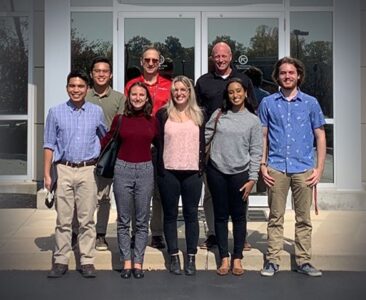Riverside Research Sponsors Ohio State University Students in the Improvement of a Long-Standing Work Process
Riverside Research, a not-for-profit organization serving the public interest, has taken on a critical role in providing college students the opportunity to directly apply classroom learning toward advanced innovation and development.

Program Manager Steve Harper Intelligence & Defense Solutions (IDS) and Senior Engineer Mark Brunn (IDS) have promoted partnership efforts between Ohio State University (OSU) undergraduate students and Riverside Research in their role as problem sponsors. Jarrod Manguiat, another engineer and team mentor, has also taken on a paramount role with his invaluable insight as a subject area expert. Dr Ashwin Fisher and the Optics group Open Innovation Center (OIC) provided invaluable technical background and guidance on circuit board imaging, Artificial Intelligence (AI) and new technologies they are exploring.
The team is comprised of multidisciplinary students; Nick Clawson (B.A.Sc, Applied Physics), Emily Haines (B.S.E Industrial Systems Engineering), David Manguiat (B.S.B.A Finance), Isabelle Rea (B.S Industrial Design), and Nina Tavernier (B.S.E Industrial Systems Engineering). The student team represents diversity in educational study and in background and expertise. Their collaboration is a result of a newly implemented course called “Rapid Innovation for Public Impact”— an OSU senior design option inspired by the well-established “Hacking for Defense (H4D)” course.
The team explored a long-standing issue regarding the process for producing an unknown circuit board’s schematic. Circuit boards are often presented to government contractors for further investigation. Their end goal is to draw the board’s schematic in order to reveal capabilities and functions of the board. Circuit boards are initially examined for malicious hardware before their multiple layers are imaged using X-Ray or Terahertz technology. Images are then used in manual production of a schematic – depicting all components and traces. This production alone contributes to a process cost of tens of thousands of dollars.
The student team investigated the integration of artificial intelligence into this manually intensive process—a solution that requires a hefty amount of data collection. The student team was able to generate an extensive amount of data needed to explore AI integration in the data sourcing phase by “crowdsourcing” the image editing process. Crowdsourcing refers to the practice of enlisting a large group of individuals to perform tasks that a computer cannot yet perform. Their solution for using established crowdsourcing platforms to generate substantial amounts of unclassified annotated images provides sufficient data for AI training to support automating schematic generation.
Riverside Research encourages and supports scientific research using internal and external resources to solve critical problems—a mission statement that the student team has remained in touch with throughout solution development.
“We are thankful to have this opportunity to provide students with real-world AI applications,” said Riverside Research President & CEO Dr. Steve Omick. “We believe this experience has bolstered student confidence in their upcoming professional environment and look forward to continue partnerships like these.”
